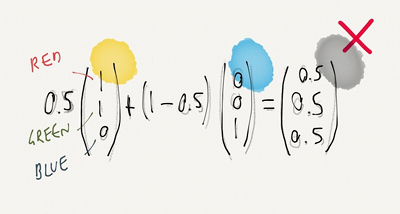Color management in the production pipeline is a tough topic. A really tough one. And a crucial one too. Unfortunately not only is this an important and difficult topic, but it also seems to me that except maybe for people working on AAA games or heavy budget film industry, most have little knowledge on the matter, when they’re not just completely unaware of the issue.
The issue that image capturing devices, screens and printers all have different color characteristics (said simply: what you scan, photography or film will not look the same depending on the capturing device used, and a same image will look different depending on the display or printing device too).
The issue that they have a capturing or display range usually far from what the human vision is capable of, and by “far” you must understand by orders of magnitude (said simply, the average human can perceive way more contrast than a camera is able to capture, differentiate much more colors than a screen is able to display, and on top of that there are colors an average screen is just absolutely unable to render, like the orange of your fluorescent highlighter for example; this one is my favorite example actually :) ).
The issue that screens and image formats use a non linear representation leading to severe errors in colors unless it is taken into account when manipulating images (said simply, ignore gamma correction in your rendering and your lighting will be wrong, ignore it when you resize images and they will look wrong too).
I just wish it were more simple and “just worked”. But until then we have to deal with it. So here goes the list of readings on this nonetheless very interesting topic.
On color management:
- Digital Color Part 1: the first part of a supposedly series of articles (at the moment I am writing this, there is no part 2 yet) on color management. This introduction is a really great read, and I definitely recommend it if you care about color.
- Cinematic Color course notes, SIGGRAPH 2012: 55 pages is quite a long read, but it is very interesting as it explains how color is handled in a film production pipeline, what are the problems, and their origin. Even if you don’t care about film making, the read is still full of insights in terms of vision, capture and rendering.
- Calibrating Lighting and Materials in Far Cry 3: this talk part of the SIGGRAPH 2012 course, Practical Physically Based Shading in Film and Game Production, explains how Ubisoft Montréal worked to ensure color fidelity in their game. In particular, one of the problems was to get color calibrated photos to make their albedo textures. Make sure to read the course notes.
On gamma correction:
- Gamma error in picture scaling: this article shows how bad things can go when image manipulation softwares don’t take gamma into account, and gives a glimpse of how widespread the problem is.
- The Value Of Gamma Compression: I like this short article a lot, as it shows in a quick a clear way how a bad gamma management can ruin a rendering.
- Gamma and Lighting Part 1, Part 2, Part 3: this three parts article from the same blog explains how they handle the issue in the production pipeline of X-Plane.
- GPU Gems 3, Chapter 24 – The Importance of Being Linear: this article explains how to take gamma into account in your rendering pipeline; while an interesting read, I think it doesn’t make the issue obvious enough (as I find the different illustrations to be equally bad looking).
- Gamma FAQ: this FAQ is quite dated but still helps understanding the origin of gamma correction and avoid confusion between various concepts (there is also a Color FAQ from the same author).
Update: this 4mn video explains quite convincingly the need for gamma correction.
On tone mapping:
Have a good read!
Update: this lengthy presentation of GDC 2010 (quoting: “The presentation is basically four 20 minute presentations crammed into 55 minutes.”), by John Hable, covers several of these topics.

